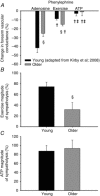Regulation of skeletal muscle blood flow during exercise in ageing humans
- PMID: 26332887
- PMCID: PMC4933119
- DOI: 10.1113/JP270593
Regulation of skeletal muscle blood flow during exercise in ageing humans
Abstract
The regulation of skeletal muscle blood flow and oxygen delivery to contracting skeletal muscle is complex and involves the mechanical effects of muscle contraction; local metabolic, red blood cell and endothelium-derived substances; and the sympathetic nervous system (SNS). With advancing age in humans, skeletal muscle blood flow is typically reduced during dynamic exercise and this is due to a lower vascular conductance, which could ultimately contribute to age-associated reductions in aerobic exercise capacity, a primary predictor of mortality in both healthy and diseased ageing populations. Recent findings have highlighted the contribution of endothelium-derived substances to blood flow control in contracting muscle of older adults. With advancing age, impaired nitric oxide availability due to scavenging by reactive oxygen species, in conjunction with elevated vasoconstrictor signalling via endothelin-1, reduces the local vasodilatory response to muscle contraction. Additionally, ageing impairs the ability of contracting skeletal muscle to blunt sympathetic vasoconstriction (i.e. 'functional sympatholysis'), which is critical for the proper regulation of tissue blood flow distribution and oxygen delivery, and could further reduce skeletal muscle perfusion during high intensity and/or large muscle mass exercise in older adults. We propose that initiation of endothelium-dependent hyperpolarization is the underlying signalling event necessary to properly modulate sympathetic vasoconstriction in contracting muscle, and that age-associated impairments in red blood cell adenosine triphosphate release and stimulation of endothelium-dependent vasodilatation may explain impairments in both local vasodilatation and functional sympatholysis with advancing age in humans.
© 2015 The Authors. The Journal of Physiology © 2015 The Physiological Society.
Figures




Comment in
-
Limitations of skeletal muscle oxygen supply in ageing.J Physiol. 2016 Apr 15;594(8):2259-60. doi: 10.1113/JP272062. J Physiol. 2016. PMID: 27079630 Free PMC article. No abstract available.
References
-
- Barrett‐O'Keefe Z, Ives SJ, Trinity JD, Morgan G, Rossman MJ, Donato AJ, Runnels S, Morgan DE, Gmelch BS, Bledsoe AD, Richardson RS & Wray DW (2013). Taming the “sleeping giant”: the role of endothelin‐1 in the regulation of skeletal muscle blood flow and arterial blood pressure during exercise. Am J Physiol Heart Circ Physiol 304, H162–H169. - PMC - PubMed
-
- Beere PA, Russell SD, Morey MC, Kitzman DW & Higginbotham MB (1999). Aerobic exercise training can reverse age‐related peripheral circulatory changes in healthy older men. Circulation 100, 1085–1094. - PubMed
Publication types
MeSH terms
Substances
Grants and funding
LinkOut - more resources
Full Text Sources
Medical

